
Acupuncture, administered with the warm needle method, in combination with drug therapy outperforms drug monotherapy in the rehabilitation of patients with heroin addiction. Researchers from the Shanghai Hospital of Traditional Chinese Medicine affiliated to Shanghai Traditional Chinese Medicine University conducted a randomized clinical trial and found that warm needle acupuncture significantly reduces pain and improves sleep quality in patients. [1]
A heroin protracted abstinence symptom score, designed by the First Affiliated Hospital of Huaxi Medical University, was used at T0 (before treatment), T1(one week after treatment), T2 (two weeks after treatment), and T3 (three weeks after treatment). The score measures three factors: somatic symptoms (muscle and/or joint pain, discomfort all around the body, powerlessness, loss of appetite), emotional symptoms (anxiety, nervousness), and sleep disorders (difficulty in sleep onset, tendency to wake up early and/or frequently). Higher scores indicate more severe symptoms.
The scores for the warm needle acupuncture group improved more significantly than for the natural rehabilitation group. The scores measured at T0, T1, T2, and T3 were 3.39 ±1.750, 2.32 ±2.001, 1.43 ±1.571, and 0.82 ±0.980 respectively. Among the three factors, sleep disorders improved markedly from 6.82 ±2.51 to 3.14 ±2.31. The score for the natural rehabilitation group dropped more slightly from 2.54 ±1.69 to 1.54 ±1.55.
The study originally included 60 male patients from Shanghai Rehabilitation Center; four patients dropped out. The remaining patients were randomized into a warm needle acupuncture group and a natural rehabilitation group, with 28 patients in each group. Ages ranged from 18–60 years. Daily drug intake was 0.5 g and above. There were no statistically significant differences in age, level of education, duration of heroin addiction, or daily dosage of heroin among the two groups.
All patients presented a strong desire for opioids and an incapability to control the onset time of drug abuse and dosage of heroin they took. Withdrawal symptoms were observed. Due to addiction, drug fastness increased, and patients’ interest in personal hobbies and social life was lost. Based on Traditional Chinese Medicine principles, all patients met the criteria of the kidney yang deficiency type. Those with severe vital organ diseases, blood diseases, severe malnutrition, digestive disorders, TB, and AIDS were excluded from the study. The natural rehabilitation group received methadone only.
The warm needle acupuncture group was given needling treatment following methadone intake. Patients faced the back of a chair and took a seated position. Patients’ arms hung over the chair back to expose the back, wrists, and legs. Needles of various sizes were applied to different body parts. For the limbs, 0.25 mm × 40 mm needles were used. For the back, 0.30 mm × 50 mm needles were used. The points used were as follows:
- T5 (Jiaji level, bilateral)
- BL23 (Shenshu)
- PC6 (Neiguan)
- HT7 (Shenmen)
- ST36 (Zusanli)
- SP6 (Sanyinjiao)
Upon obtaining deqi, 18 mm × 20 mm moxa was connected to needles at the Jiaji and Shenshu acupoints. The moxa was kept 2–3 cm away from the skin, lit at the ends near the skin. Warm needle acupuncture was administered for 20 minutes daily for 10 days.
The infrared thermal stimulation from the moxa is key to the treatment. Warm needle acupuncture stimulates biological responses and regulates immunity. The research made an interesting comment; the fragrance from the moxa can activate the meridians of the body and soothe the brain. Based on the data, the researchers conclude that warm needle acupuncture in combination with methadone is effective for heroin withdrawal treatment. [2]
References:
[1] Gao Xiaoyue, Liang Yan, Huo Lili, Yu Jie, Gu You, Xu Chayue, Effect of Warm Acupuncture on Protracted Withdrawal Symptoms in Heroin Addicts of Kidney Yang Deficiency Pattern, Shanghai Journal of Acupuncture, October, Volume 40, Issue 10.
[2] Wu Huanjin, Liu Ligong, Chen Yuelai, The Inheritance and Innovation of Acupuncture Methods, Shanghai Journal of Acupuncture, 2007, 26(12):39-41.


